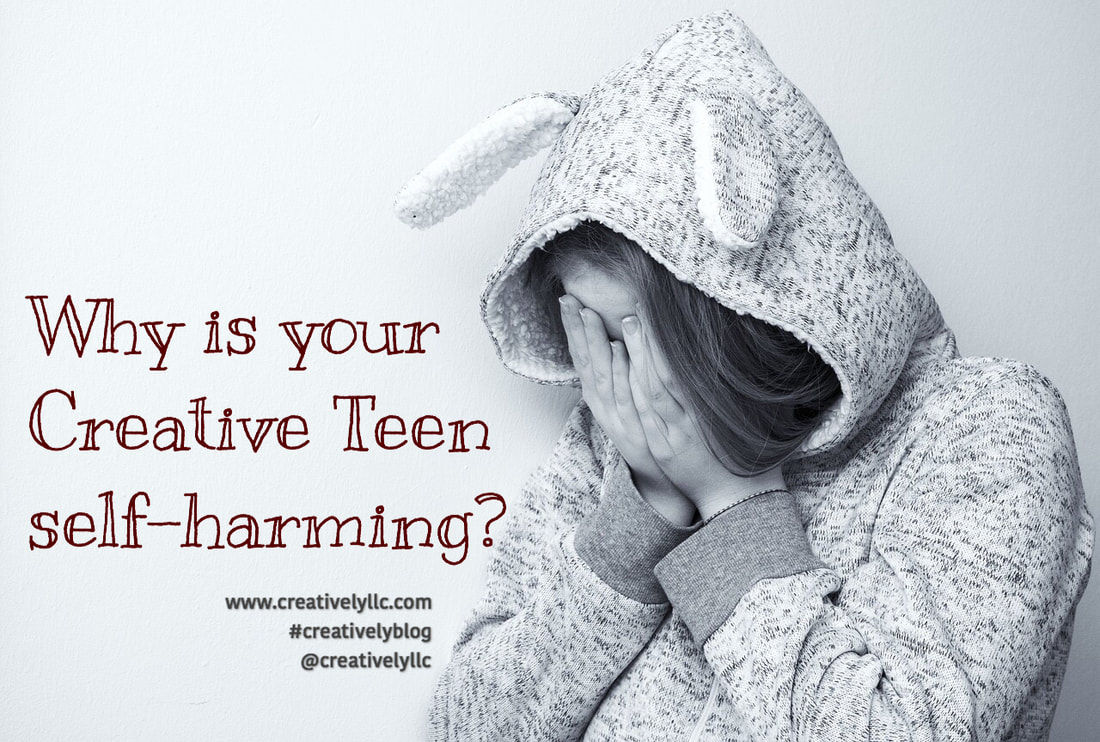|
Why is your creative teen self harming?
Self harm is a scary thing to see, hear or talk about, but it is nonetheless prevalent among today’s teens. If your teen, one of their friends, or other young people you work with have talked about it, you may feel unsettled, unsure and alarmed. In today’s blog post I want to dedicate some space to starting to demystify this behavior and talk about why it exists, the purposes it may serve and how to address it. Let’s start with some developmental psychology to set the stage of why the classification of behavior known as “self harm” is so prevalent among teens: Teens are children who, due to the natural societal progression in age milestones, have more stressors. They are more socially aware of friendship dynamics, they are beginning to question, identify and build independence and self-esteem. They have demands at school and are becoming aware of learning strengths and weak points. With all these things at play, their stressors have increased. However, they are still children, and their ability to handle the added emotional response to these new stressors may not have grown with them yet. In other words, they have lots of feelings, without necessarily more ability to deal with them (think an older stage of toddler temper tantrums). Along with growing stressors and limited control over emotional responses, teens are in a unique stage of neurological development where the separate hemispheres of the brain, while still building connections separately, do not yet have many pathways that connect them (think dirt roads vs super highways between the spheres). This means limited executive function capacity. Limited multitasking. Slower neurological processing time. Slower to make higher level connections. Slower to see big picture and build insight. Still very much functioning in the “here and now” of children, they are simultaneously growing into the higher level intellectual capacities of an adult (you may see, for example, your teen is very smart but has limited “common sense.”) Under these developmental pressures, teens may feel a disconnect between their strong emotions and how to handle them. They may feel a loss of control and an intense period of change personally and in terms of worldview. They are looking for ways to manage this discomfort and change. But why something like self-harming? One reason is that teens subconsciously use self-harm behavior to ground themselves and assert control. In this capacity, self harming serves to take them out of their spiraling headspace, into the current moment, while giving them a ritual or routine that is all their own. In younger children, we may see behaviors like resistance or regression with toilet training serving a similar function. Remembering our teen’s limited executive functioning and “common sense,” asserting control over ones’ own body is the “low hanging fruit” to manage the chaos of change. They are not rationally selecting a coping skill- rather experimenting with cause-and-effect choices over their own body. Self harm, of course, is not an ideal or healthy coping skill, however it is unfortunately one of the most accessible (control using one’s own body) and biologically very rewarding. Another reason teens self harm is for the biological reward. A natural response, especially in children, to change, chaos and stress is to dissociate or numb themselves. This is a natural built in survival mechanism, but one that most children find unwelcome and depressing over time. In an effort to “feel something again” a teen may turn to self harm. Unfortunately, self harm is very effective in fixing this problem because it causes a natural chemical reward in the brain- another built in biological survival tool- happy hormones are released to offset the physical injury. The combined effect is momentary pain, followed by a rewarding natural chemical rush and temporary relief from numbness. While again this is not a healthy way to reach these goals, knowing the motivations of the behavior can help you introduce the same rewards to your teen in better ways. Some things you need to know about self harm and your creative child: creative kids feel emotions deeply. This can make them more susceptible to finding relief with coping skills that are more extreme (because they are feeling more extremely!) Creative personalities also have the tendency to romanticize suffering- and in a childlike way the self harm can feed into this. Adults have the benefit of life experience to offset some of the romanticism to pain and chaos that children have yet to experience. So when should you worry? We need to remember and balance two important things when it comes to self-harm in our teens: one, self harm as such is not suicidal. If we are indeed talking about self harming behaviors as separate from depression and suicidal thinking, then the goal of self harm is not to actually harm onesself, especially permanently. However, the second thing to remember when it comes to self-harm in our teens is: teens and children are by nature impulsive. They have fewer protective factors, responsibilities, and less life experience to offset risk. As such, any talk of self harm should be taken seriously and immediately precipitate evaluation by a clinician, doctor or other licensed and capable professional. I would introduce a discussion on this topic without also giving you some tools to help your teen. Assuming you have involved a clinician/doctor/licensed professional as part of your process, here are some other recommendations to support them: 1) Talk. To. Them. Ask them questions. Show them love and interest. Show them you are a safe person to go to with your feelings and that you will hold and support them through whatever treatment they need. 2) Creative kids have their best coping skills built in: make art! I have researched and presented on this repeatedly throughout my career and I cannot emphasize this enough: if you have a creative child, they NEED to be creative in order to stay well. 3) It is ok for them to make scary art. If your teen wants to draw, paint, sculpt, write, or otherwise express the intrusive thoughts of self harm or other strong emotions that they are feeling, it is ok and it is healthy. The images or words may seem disturbing to you, but your teen is feeling relief from expressing and communicating them. 4) It is ok for your teen to cry intensely. Again- think of the toddler temper tantrums. Your teen is learning how to manage their growing stressors and strong emotions, and natural releases of emotions will help them be more successful with their coping skills. I know it is hard to do, but allow them a safe space to cry and emote, then be there for them afterwards to support them. 5) It is ok for them to talk about it to others. In the same vein as the emotional expression, talking about it with you, with friends, with other safe people gives your teen a way to make much needed neurological connections to deal with stressors better. 6) Help them find other emotional outlets. This may look like music. Arts. Sports. What helps them feel control over releasing some of the emotions that they are carrying? 7) Give them some control. Find ways to help your teen have control in appropriate ways in their lives. Is their a volunteer project they can participate in that will allow them to feel control and success? Can you let them choose something about their daily routine? Get creative. 8) Teach them mindfulness and grounding. This one, if you aren’t familiar, is a good one for you both to learn together. Try meditating. Try sensory practices together (cooking, hiking, swimming). Help them use soothing objects (pets, blankets, foods, music). The idea is to come out of the racing thoughts in the mind and be fully present in the moment. These are just some ideas and there are many others. The best approach is one collaborative between you, supportive people in your teen’s life, and seasoned professionals to make a diversified team effort that is catered to their individual needs. So, in summary: don’t panic, get help, and with good support better coping skills will be learned to replace this unwanted behavior. If you have concerns about your creative teen and self harm, don’t wait- give me a call- I can help. (C) 2018 Creatively, LLC Comments are closed.
|
get more from The Creativity CoursesLiking educational topics and knowing what's hot in creativity? Creatively has online courses, with an interactive creative community, coaching sessions and more in the Creativity Courses. Want these blogposts in a newsletter? Subscribe here, and get a free gift. Cindy Cisnerosis a Creativity Coach, Creative Therapist and Professional Artist in Sykesville, Maryland. She is an expert straddling the realms of arts, creativity research, psychology, therapy, and coaching. She provides Online Creativity Counseling in Maryland and Virginia, and Online Creativity Coaching throughout the USA, Canada and the UK tailored for the discerning, imaginative, artistic, and neurodiverse. The information provided in this blog is from my own clinical experiences and training. It is intended to supplement your clinical care. Never make major life changes before consulting with your treatment team. If you are unsure of your safety or wellbeing, do not hesitate to get help immediately.
Archives
July 2024
|
|
Concierge Therapy for Creatives in Maryland
Creativity Coaching Worldwide including the USA, UK and Canada |
Telephone |
|


 RSS Feed
RSS Feed

